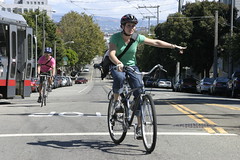The fatality rate for every million hours spent cycling is 0.26, compared to 0.47 per million driving hours (on-road motorcycling comes in at a whopping 8.80 deaths per million motorcycling hours). For every million cyclists in the US, 16.5 die each year, whereas for every million motorists, 19.9 die each year.The author discusses risk quite a bit more and talks about commute homeostasis and the factor of improved health of cyclists, but in the end he concludes that cycling is a relatively safe activity.
Another way of evaluating risk is to examine the odds of dying if you do crash. The odds of dying from a bicycle crash are one in 71. This compares to one in 75 for a light truck (pickup truck, SUV, van), one in 108 for a car, one in 43 for a truck, one in 26 for a motorcycle, and one in 15 for a pedestrian.
In other words, the odds of dying in a bike crash are about the same as the odds of dying in an SUV crash. The false sense of security that comes from an SUV tends to produce far more dangerous driving behaviour.
Part of my mission at Cyclelicious is to note that bicycling is a safe activity. There's a perception among too many that bicycling is a dangerous activity -- it seems counterintuitive that sitting exposed in traffic on a bike is about as safe as riding inside of a metal cocoon. McGreal makes an important point in his article that our riding behavior can have a significant impact on risk. Following the rules of the road and an educated awareness of traffic risks reduces the risk of injury collisions significantly.
If you want to be a safer cyclist, read Ken Kifer's archived information on bicycling safety. I recommend the book The Art of Urban Cycling by Robert Hurst, which is good for all kinds of city cycling, not just downtown urban cores. I also recommend the League of American Bicyclists bicycling education courses for instruction in safety and bike handling skills. Even if you're an experienced cyclist, you can learn quite a bit from taking the LAB classes.
A hat tip to Paul Dorn for pointing to the risks article. He also posted good commentary on motorist advocacy in Seattle.
Photo credit: "Hand Signal" from San Francisco Bicycle Coalition.


great link fritz! thanks for sharing. something i alway weigh is the risk i put myself at when i get behind the wheel, whereas i have always perceived my long distance cycling habit to be the riskier of my choices.
ReplyDeleteI do feel more vulnerable on my bike but I think how someone rides makes a big difference in safety. I won't ride with even one earpiece as I think it reduces awareness of what's going on.
ReplyDeleteRoute choice also makes a big difference although roads that seem safe can lull me into not paying attention. I have quit doing one of my favortie 200 mile rides from Colorado Springs to Glenwood Springs because of worries about narrow roads and lots of high speed traffic. I've replaced it with a ride to Avon that's 190 miles and avoids the busiest section of the ride to Glenwood.
"I do feel more vulnerable on my bike"
ReplyDeleteIronically, that's part of why you're safer. The reverse is people in SUVs who think they're totally safe and end up lying sideways in a ditch during a light snowfall.